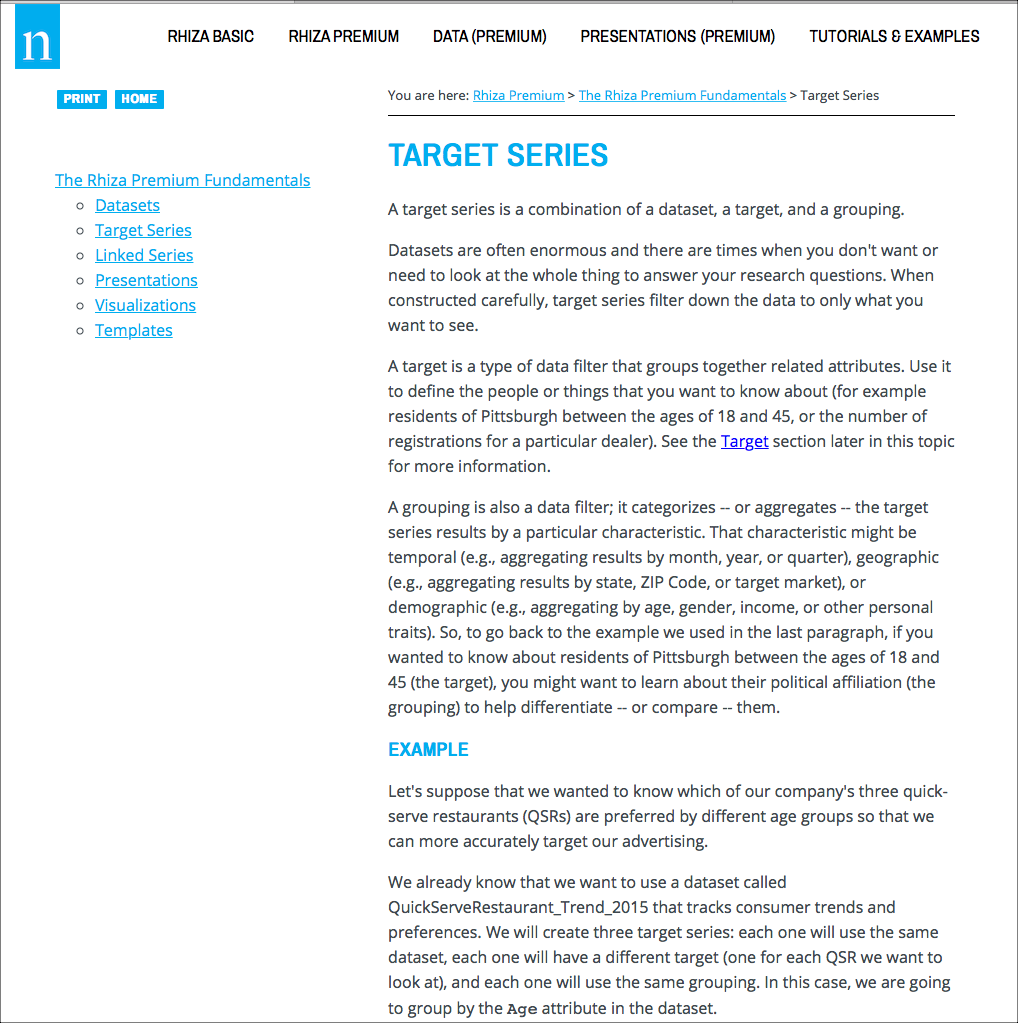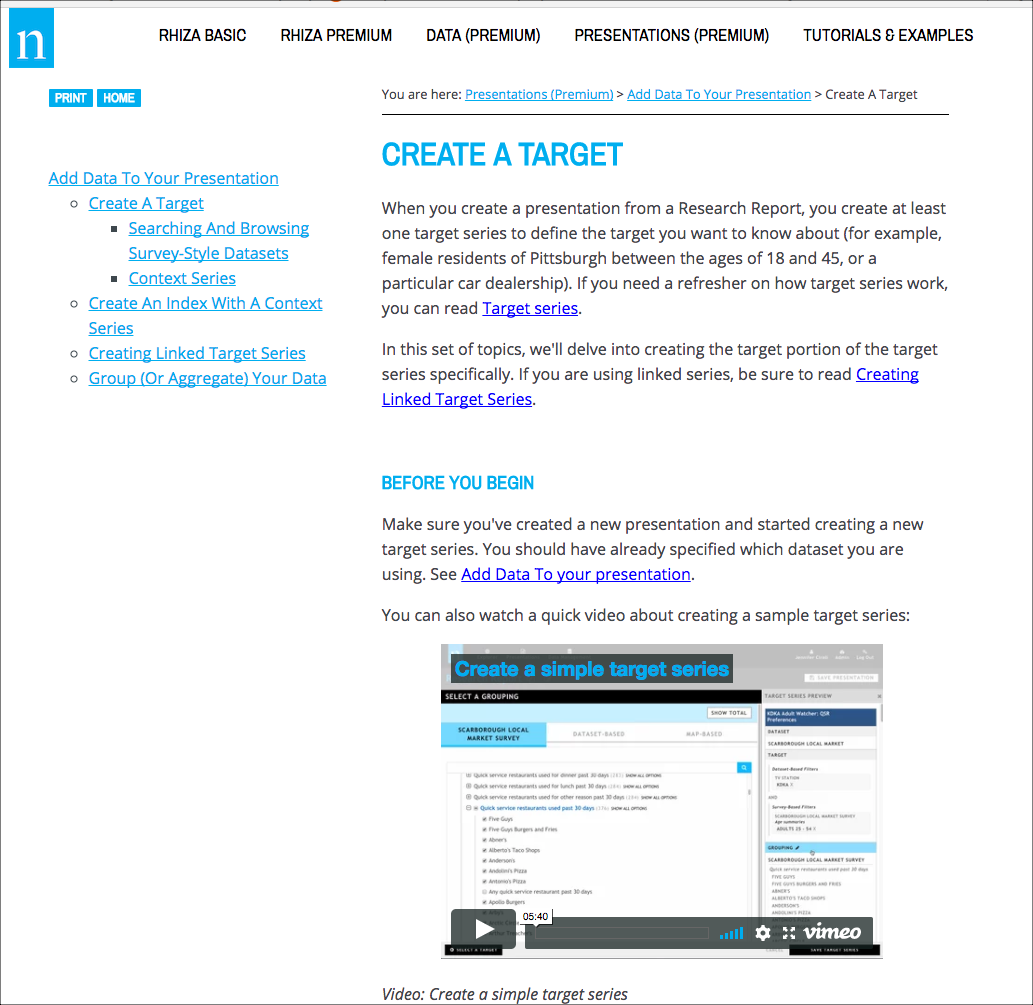Rhiza/Nielsen: Strategy, content, & training
Helping users tell beautiful, data-driven stories through technical content and training.
key skills: Verbal and written communication; structured authoring (XML); video creation; content strategy; information architecture; stakeholder and customer interactions.
The problem
When I started, Rhiza’s SaaS-based data visualization software had been sold to large media groups (Cox, Comcast, BBC) — researchers could combine powerful datasets to uncover and visualize insights that helped sales teams plan, buy, and sell media.
But they didn’t.
The product was complex and there was no real training or documentation. To complicate things further, each customer had its own version of the product, with slightly unique functionality and different datasets. Sometimes, the product even had a different name.
The customers were frustrated. The company was frustrated, too: The tool was under rapid development and there was no way to convey the changes to existing users, or show how awesome it was to potential customers.
Time to triage.
The solution
Before I could create content to support use cases and goals, I needed a scalable strategy and information architecture. I also chose tools for structured, single-source authoring, content management, and rapid publishing.
Using the strategy and tooling, I then created and delivered a robust set of technical content:
XHTML-based knowledge centers for each service & version, with topics, videos, and tutorials (see snippets below)
Embedded assistance/online help to increase product usability
Role-, service-, and skills-based training curriculum that blended modalities and used hands-on application of skills to solve relevant problems
For each monthly release, I assessed and iterated on the content based on customer and stakeholder feedback
Knowledge Center (KC)
I authored and published the KC with Madcap Flare; content was conditionalized and reused whenever possible across Basic and Premium services to drive efficiency and consistency.
The KC included short video tutorials (Camtasia) and graphics (SnagIt) to supplement the text.
Images in the gallery are a representative sample; the live KC is behind a firewall. To enlarge any image below, click it.
Training
My first training session was in-person. About two weeks prior, I sent users a pre-training survey to help me tailor the content and the exercises.
It was… enlightening. Users didn’t understand or like the software — it was too complex and they didn’t see how it could help them accomplish daily tasks and meet quarterly sales targets.
Before the session, I surveyed the users: What were their goals and typical tasks? Their attitudes toward the software, and perceived skill levels? Their specific frustrations?
Strategy, content, & training: Rhizalytics
-
The problem
Comcast and other enterprise clients needed a cloud service (including a database) so they could visually represent data for internal reports and external presentations.
Although the service was complex, technical content was limited to problem-and-solution FAQs. Customers were confused and frustrated, and adoption was low.
To complicate matters more, each customer had its own version of the service with unique capabilities and use cases until the company was able to create two distinct services with two distinct target users.
-
The solution
Before I could create content to support use cases and goals, I needed a scalable strategy and information architecture. I also chose tools for structured, single-source authoring, content management, and rapid publishing.
Using the strategy and tooling, I then created and delivered a robust set of technical content:
XHTML-based knowledge centers for each service & version, with topics, videos, and tutorials (see snippets below)
Embedded assistance/online help to increase product usability
Role-, service-, and skills-based training curriculum that blended modalities and used hands-on application of skills to solve relevant problems
For each monthly release, I assessed and iterated on the content based on customer and stakeholder feedback.
Knowledge center (KC)
I authored and published the KC with Madcap Flare; content was conditionalized and reused whenever possible across Basic and Premium services to drive efficiency and consistency.
The KC included short video tutorials (Camtasia) and graphics (SnagIt) to supplement the text.
To enlarge any image below, click it. These are representative samples; the live KC exists behind a firewall.
Knowledge center main page: Nav & search
Knowledge center main page: Onboarding materials
Knowledge center main page: Video tutorials
Knowledge center: Conceptual topic
Knowledge center: Task topic
Knowledge center: FAQ topic

















